One of the most misunderstood aspects of the Lambretta engine is the gearbox and its various options, but it doesn’t have to be all that complicated. Stu Owen explains…
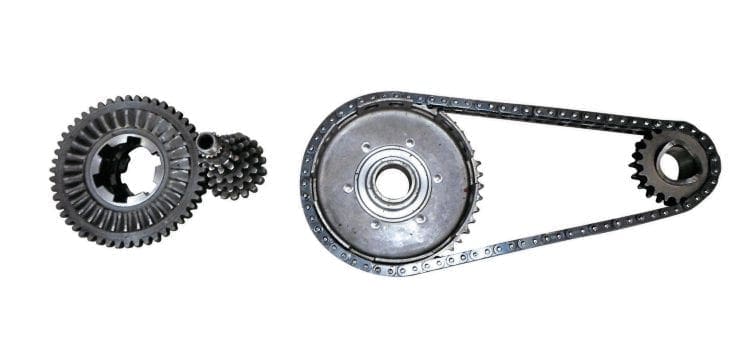
The Lambretta engine is a simple but ingenious design. It’s neat, compact, and when you think about it… not only does it house a chain drive but also a four-speed gearbox (now five-speed in some cases). To get all this in such a small area was quite a remarkable feat at the time of its conception. Innocenti was smart in how it went about the gearing requirements for each model… changing the ratios depending on the capacity and power output with great ease.
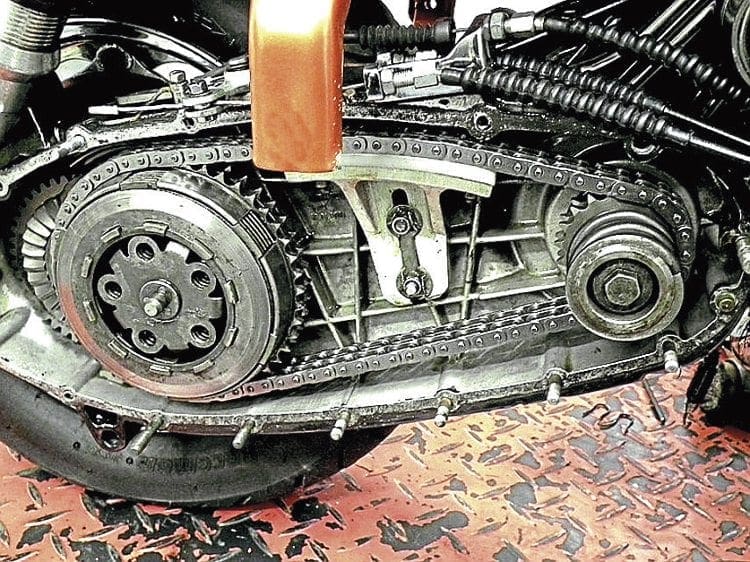
Here is where it gets a little complicated though, as models ranging from the Li Series 1 right up to the Grand Prix all had gearboxes that were interchangeable with each other. Chuck in the fact both the front and rear sprocket were also interchangeable and you have a vast amount of gearing options available. This is where people start to get confused. So the question is… which gearbox best suits a certain engine and what sprocket choice is exactly right to use with it?
What defines the gearing?
If you ask Lambretta owners what gearbox they have in the engine, some will not be able to answer correctly. Even if they do, chances are they will not know what sprocket combination it has fitted. When gearing is termed short or tall, or low or high, it quite often puzzles people. The reason gearing is so important is that the Lambretta is a two-stroke engine, therefore it will have an area in the rev range where it produces most power, commonly known as the power band.
If an engine is below the power band then it will struggle to pull the gearing. If it’s gone past it then the power will be fading off and you will be over revving the engine for very little reward. We will use the terms short and long when it comes to describing gearing in this article. The easiest way to explain each is short means going through the gears very quickly so acceleration is good but top speed is reduced because it’s revving flat-out too quickly. Long means acceleration is slower as the engine pulls through each gear but gains a much higher speed before it manages to achieve maximum revs.
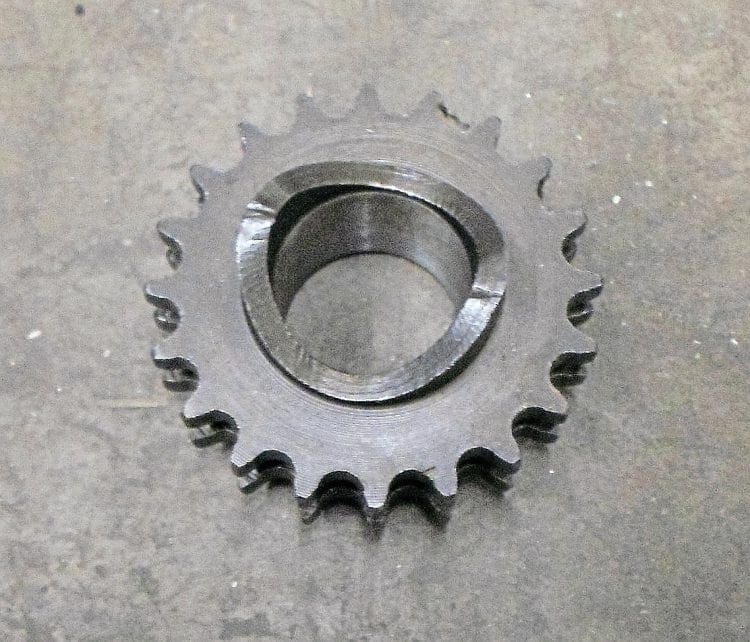
The problem is the Lambretta engine has only got four gears, which holds it back considerably when trying to stay in the power between gear changes. Though there are five-speed options now becoming more frequently available, the majority of Lambretta owners will only have a four-speed one fitted. Therefore this article is purely based on the four-speed box. It doesn’t matter whether you have a totally standard Lambretta engine producing 10bhp or some monster tuned engine with 30+ bhp the principles still remain the same. The correct gearing gives you best performance.
The easiest way to start looking at how gearing works and what governs it is by breaking it down into its separate components. The power the top end creates is transmitted from the end of the crankshaft upon which the front sprocket sits — so that is the first stage. This is then connected to the crown wheel by the chain — so the crown wheel is the second stage. From that point, it goes through the clutch directly to the gear cluster and gears so this is the third stage. Finally, it leaves the engine through the layshaft to the rear wheel. This has a specific tyre size diameter and so is the fourth and final stage. Looking at it this way means gearing can only be altered by these four components and nothing else.
Which is the most important?
Though we have established there are four different areas that control Lambretta gearing, the main factor is the gearbox itself. That is the most important and the other ones work around it as such. The first decision is which gearbox best suits your engine and will utilise the power to its full potential. Again for the purpose of this article, we will concentrate on the gearboxes Innocenti created. Though there were different ones from India and Spain they only have slight variations on certain gears so we will leave them alone to avoid further complication. In total, Innocenti created seven different four-speed gearboxes. Some of them are unique to one model whereas others were fitted into several, remembering though all were interchangeable.
If you ask anyone which Lambretta gearbox is best you will probably get a different answer every time. There are, however, some that are poor in comparison to the others and are best left out of the equation completely. There are two that stand out in this category and they are the TV200 and the SX150/GP150. The problem with the TV200 is that its gearing was too long for a lot of engines, often meaning that an engine won’t pull fourth gear and therefore you have to constantly change down from fourth to third. With the SX150/GP150 this has a huge gap between third and fourth and though you may accelerate well, again it’s hard to keep the engine in the power as you change into fourth.

The five remaining ones — the Li 125, Li 150, SX 200/TV 175, GP 125/200 and the Pacemaker — all are usable within a certain degree. Arguably the best of the lot is the Pacemaker gearbox and it’s baffling why Innocenti didn’t use it in all their engines once it was introduced.
With the percentage changes between all four gears as close as possible and by using different sprocket combinations, it makes it usable from basic/standard engines, right through to tuned ones. The only problem is not that many were made so they are increasingly hard to come by. That’s why it is not used as much compared, for instance, to the Italian Li150 of which there is an abundance. So if you are building an engine up from new, for instance, any one of these can be fitted but they will all need the right sprocket combination.
Altering the gearing
Whichever of the gearboxes mentioned is fitted in your engine, how it works in comparison to the way it delivers the power is controlled by the sprockets and tyre size. For now, we will presume that the tyre fitted is the standard 350-10 and come back to any changes with it later. Sprocket choices are what start to make everything complicated and is the area that confuses most owners. Apart from the GP200, all Innocenti sprocket combinations were 15 teeth on the front sprocket and 46 on the crown wheel. The GP200 uses 18/47.
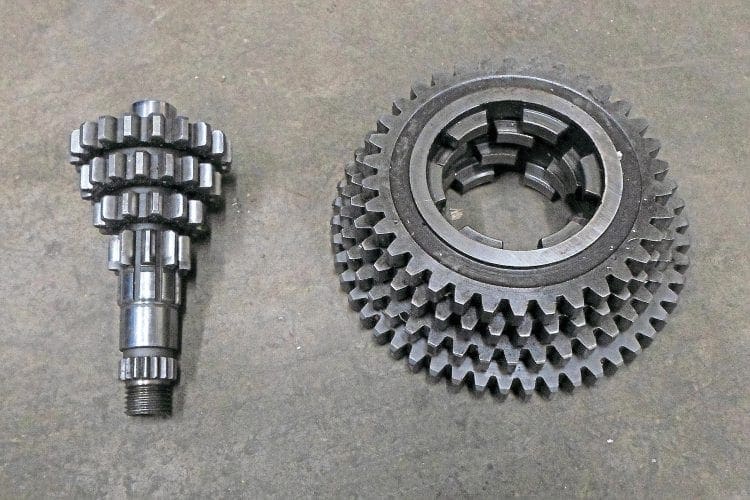
Though you want good acceleration and even gaps between each gear change the most important gear of all is fourth. This is the gear you will spend most of the time in out on the open road. If the sprocket combination is too short, for instance, it means you will be flat out in fourth gear too early and have your cruising speed way to low. If it is too long, chances are you will never get fully into the power and start having to change down a gear to try and get the engine in the power again.
There are many formulas and equations in calculating gearing but in this article we will only concentrate on one, which is the final ratio. Though it is helpful to know it in each gear, it is most important in fourth gear. For an example, we will take the factory SX200 gearbox which has a final fourth gear ratio of 4.82 if using 15/46 sprockets and gives you a speed of 10.5mph for every 1000rpm. Therefore if you were doing 6000rpm in fourth gear you would be traveling at 63mph.
Now that is understood, let’s look at the Pacemaker gearbox and show how sprockets start to affect gearing, certainly in a higher rewing engine. From the factory, it had 15/46 sprockets which gives a final drive ratio of 5.65 and 9mph per 1000rpm. That’s fine in its standard specification with just 7.5bhp but what if it were fitted in a tuned TS1 with 26bhp that had peak power at around 8500rpm?

That would mean at those revs you would be doing 76.5mph, but the engine would be screaming—certainly if you were on a motorway and if you wanted to cruise at 6000rpm and only be doing 54mph. By altering the sprocket combination to 18/47 this now gives a final drive of 4.81 — very similar to that of the SX200. However, because the pacemaker gearbox has a closer set of ratios the TS1 engine will now probably pull even longer gearing. If it’s now changed to an 18/46 sprocket combination that will give a final ratio of 4.71 and 10.7mph per 1000rpm. That will mean at peak power it is capable of just over 90mph and if cruising at 6000rpm a speed of 64mph. So even though it’s the same gearbox, by using the different sprockets vast differences in cruising and top speed are achieved.
You could argue why not make the gearing even longer by changing the sprockets again to go even faster. The problem is, you wouldn’t be able to pull it in fourth gear and not be able to keep in the power band, meaning constantly changing down. That is the problem of the four-speed gearbox as highlighted earlier. Because the percentage jump between each gear is bigger than a five-speed, it becomes more difficult to keep it in the power. If a five-speed were fitted it would make that less of a problem and so allow you to have longer gearing.
What gearing suits my engine?
The question of how you gear your Lambretta depends entirely on what power and state of tune it is in. It also depends on a lot of other factors such as where the power is produced and what pipe you are using. With a fairly standard engine producing around 10bhp you want a final drive in fourth gear of around 5.00. If it has around 20bhp then it wants to be 4.80. At 25-30bhp then 4.70, possibly down to 4.6. There are cases of much higher powered tuned engines producing well over 35bhp which can start looking towards 4.50 to 4.30 but a lot will depend on where the power is created.
Other factors that affect gearing
Changing your sprockets to alter the gearing is a bit of a pain as it involves taking the transmission out each time. However, you can make slight alterations by changing the tyre size on the rear wheel. There are several you can use and the smaller the diameter, the more revs it takes to get to the same speed compared to the standard 350-10 size. So it is like going down on the front sprocket, slightly improving acceleration. Going over the standard tyre size is complicated as the only real solution is 400-10 and not only does it add way too much gearing in one go but also is awkward to fit because of the bump stop so not worth bothering with.
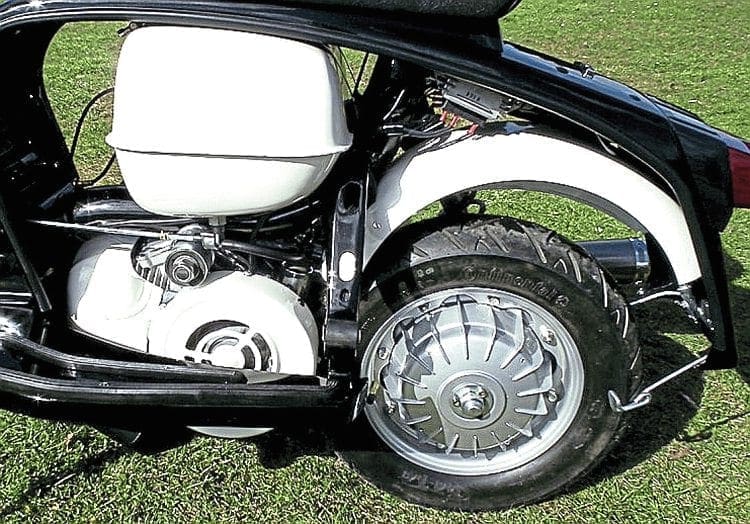
The next thing to look at is what you use your Lambretta for. If it’s a street racer that doesn’t take a pillion then it will be much lighter. Presumably, it will have a tuned engine so longer gearing is an easier option due to the fact that the engine will be able to pull it. If you are doing a lot of motorway touring and two up then you will want as much gearing as possible for higher cruising speed but not too much as the extra weight will mean it won’t be able to pull between changes. If you have a sidecar fitted the biggest problem is getting it moving so a higher first gear ratio may be necessary.
Make use of your dyno graph
These days the majority of people put their scooter, whether it is a Lambretta or a Vespa, on a dyno. Regardless of how much bhp you have, big or small, there will be a point where you are getting usable power. That is the area on the graph where between a certain rev-range the line will be flat before dropping off. That will be the usable spread of power. This is ultra-important if you are racing or sprinting but it can also be put to good use on the road.

For instance, the majority of tuned Lambretta engines tend to start making good power around 6000rpm which will carry on to 8000/8500rpm normally. Therefore if you are accelerating hard don’t go over 8500rpm as you will be slowing down as you have gone past peak power and you should be changing up a gear. Also if you are cruising in fourth gear at 6500rpm, for example, you know you have got at least 2000rpm to use if you want to overtake with ease.

Fitting a rev counter will mean you will know exactly where your revs are and if you learn your dyno graph you will know exactly where to change gear, making the most of the power you have. If you have over geared your engine too much and you can’t get to the higher part of your usable power or its struggling sometimes then a rev counter will clearly point this out.
Trial and error
When it comes to choosing the correct gearbox and sprocket combination then it is all a bit trial and error. The descriptions in this article of which gearing suits your engine best is a guide to near enough where you want to be or certainly a good starting point. It may be that you can pull more gearing than you thought or perhaps you have too much and the engine is struggling. That is where fine tuning comes in and though it may be a pain to change a sprocket, when you get it right the rewards are definitely worth it.
GUIDE TO FACTORY GEARBOX OPTIONS
Li 150: A fairly good gearbox in general but there is a bit of a gap between third and fourth gear. This is okay in smaller powered engines but it can be a bit of a problem when changing up into top gear on a tuned engine. The reason being the gap becomes more noticeable as you start to go up on the sprocket sizes.
Li 125: This has a very short first gear which is ideally suited if you have a sidecar, helping you to get moving from a standing mass much easier. Though there is a bit of a gap up to second gear you can get away with it easier than if it was between third and fourth. If using a sprocket combination of 18/47 it gives you that magic 4.8 final drive ratio so is a good gearbox to use when looking for that figure.
SX150/GP150: With a huge gap between third and fourth gear it’s almost impossible to stay in the power even on a standard engine. No use in anything really, hence why they are so cheap to buy.
TV200: Though each gear is fairly evenly spaced, its final drive in fourth gear of 4.46 makes it almost unusable except in the case of very high powered engines.
SX200/TV175: Using the standard 15/46 combination it gives you a 4.80 final drive so it is good for a lot of engines. However, if trying to go longer on the gearing with a bigger front sprocket it can struggle a bit from the jump between third to fourth.
GP125/200: Regarded by some as the best gearbox to use in general. The main problem with it though is to get the desired final drive past 4.80 you need quite a big front sprocket. This makes the chain size bigger so it can be a bit of a pain when finding one to fit.
Pacemaker: When using the later version, this is without a doubt the best gearbox to fit in your Lambretta. With fairly even gaps between each gear and a close third to fourth, it’s ideal in anything from a standard engine to even the most tuned. Simply by changing the sprocket sizes, any Lambretta engine will benefit having one fitted. The only problem is beware what you are getting when purchasing one. The early pre-modification ones had a weak third gear which is very fragile and prone to breaking a tooth off the gear cog. Only the past-modification type will be strong enough even in a mildly tuned engine.
MORE READING…
The ideal place to find facts and figures on gearing and the final drive ratios for all Innocenti gearboxes is in these publications. Alternatively you can go online and use the gearbox calculator at scooterhelp.com by following this link www.scooterhelp.com/tuning/gearing.html which is easy to use. They have a comprehensive guide to both Vespa and Lambretta gearbox options.
For the best results though, go to the website of Tony Cassidy. He has a downloadable gearbox visualiser that covers almost every gearbox ever made for the Lambretta. With a wealth of information, it will help you to not only make the correct sprocket choice but also give you an understanding of how gearing actually works. Visit his website at www.avantone.wordpress.com
Words & Photographs: Stu Owen





